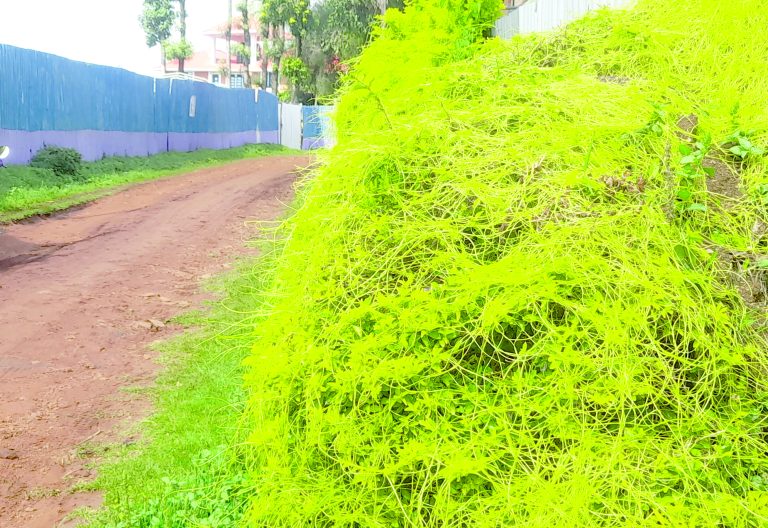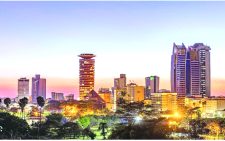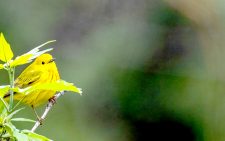Indifference as invasive weed chokes Kenya

An ecological threat is unfolding in Kenya, as a parasitic weed continues to spread its tendrils across the nation.
Identified as the dodder, a rootless and leafless weed that falls under the genus Cuscuta has also been reported in other parts of the world, including Japan and the United States of America (USA).
In Kenya, this vine weed has not spared key government institutions including, and perhaps ironically, the University of Nairobi (UoN). At this institution of higher learning it has invaded flowerbeds, hedges and ornamental trees.
The flowerbeds outside UoN Towers and the Engineering Department are among those affected, just like those around the Kenya Broadcasting Corporation and the nearby Norfolk Hotel.
The weed, which looks spaghetti-like when scattered on a surface feeds on its host and eventually suffocates it, has been spotted in other counties including Bomet, Narok, Nyamira, Kisii, Kisumu, Homa Bay and Kakamega.
The Food and Agricultural Organisation (FAO) warns that the weed poses a “significant threat to crops and biodiversity”. According to FAO the weed exists in 150 varieties, which are widespread in various countries of the world.
Dodder mainly presents as a yellow-orange, leafless, thread-like vine that grows over its host’s leaves, branches, and stems as an entangled, smothering web.
In 2020, the Kenya Forestry Research Institute (KEFRI) warned that if dodder weed is not kept in check, it poses a weighty threat to food security that will likely become disturbingly evident by 2029.
Interviews show that the weed destroys crops such as tea, avocados, maize, sugarcane and bananas.
“I have seen the weed in many parts of Nyanza and Western. I don’t know where it came from but it’s a danger to our lives because it kills its host,” says Mary Agwata, a resident of Kisii who lost part of her hedge when it dried up following the invasion of the weed.
When the weed attacked their hedge, they cut it at stump level and thought the weed would die but it reappeared as soon as the hedge regained its life. They were forced to cut down the hedge.
Owing to the weed’s survival abilities and rapid spread, questions linger as to how it reproduces, what are its transporting hosts and its resistance and or survival adaptation.
Research shows that dodder seeds germinate near the soil surface and send up slender, thread-like twining stems without any cotyledons (seed leaves). The stem sways slowly until it touches the stem or leaf of another plant and begins to wind around it.
Mary believes that the weed originated from around Lake Victoria and found its way to Kisii through the transportation of sand that’s used to construct houses.
“I first saw dodder around Ahero in Kisumu. I think it was transported by humans to other regions,” says Julius Bosire, a member of the Agricultural Society of Kenya (ASK), Kisii branch.
Prof Peter Otiso, a Kenyan geographer based at the Bowling Green State University (BGSU) in the United States says that dodder grows better in warmer climates and is usually at its best in spring and summer.
“The weed has caused a scare because it’s a threat to food security. There’s a lack of push by the government and researchers to find out how it can be controlled,” says Peter Ndung’u, a retired biologist.
Researchers say that dodder produces by seeds, which can be dispersed by machinery, water, contaminated planting seed, and soil movement.
“Once established, this is a very difficult weed to control,” says a joint study by agronomists and weed scientists in a report published on the Texas Agri-Life Extension website.
Rapid spread
The researchers, Jourdan Bell, Peter Dotray, Lubbock Scott Nolte and Muthu Bagavathiannan found out that when germinating from the soil, dodder can survive for 10 days, although it must find and attach to another plant or it dies.
In a comprehensive guide for handling dodder, KEFRI says the genus ‘Cuscuta’ is found throughout the temperate and tropical regions of the world, with the greatest species diversity in sub-tropical and tropical regions. Dodders are prolific seed producers, each plant being capable of producing several thousand seeds per season.
“Although only about 5 per cent of the seed germinates in the year following seed production, the remaining seeds remain dormant in the soil and can be viable for more than 20 years, depending on the species and environmental conditions,” the guidelines say in the report that is available on the KEFRI website.
The guidelines have been co-authored by Mutitu Eston, Njuguna Jane, Kimondo James, Amwata Jared, Mwangi Linus, Cheboiwo Joshua, Gathogo Miriam and Kariuki Barbra.
“The rapid spread and a large host range indicate that dodders are likely to threaten sustainability of many crops, shrubs and trees, if left unmanaged. It is projected that dodder invasion will lead to huge agricultural yield loss by 2029,” the researchers say.
According to KEFRI, four herbicides (Gramoxone 200 SL, Agrimine 2-4D, Willosate 360 SL and Herbikill 20SL) have been identified to manage dodder.
However, weed and environmental scientist, Ratemo Michieka says the weed is difficult to tame by use of chemicals or herbicides.
“I tried to spray during my research trials but the succulent tendrils wouldn’t be penetrated by herbicides,” Prof Michieka, who is also the Chancellor of Tharaka University, says.
The scholar believes the weeds should be removed manually and be burnt. Manual destruction of the weed is however complicated by the fact that one is likely to damage the hosts too.
Prof Evans Basweti, an agronomist at Kisii University contends that there is no effective chemical or biological control, adding that it should be removed by hand.
“Remove the dodder stems by hand and prune the affected tree or plant to control it,” the professor says.
However, Carren Burkey, a Kenyan scientist based at the Bowling Green State University (BGSU) –US says the weed may be controlled by use of pre-emergent herbicides such as Kerb (Promide), Tretfan (Trifluralin and Prow (Pendimethilin).
She adds that destroying the weed through burning may not be effective as the seeds may escape in the air and find survival elsewhere.
Since there are various types and extent of dodder spread, there’s no standard herbicide that’s recommended for their control, she argues.
“For instance, in commercial fields, one should use pre-emergent herbicides such as Triflurian before dodder seeds germinate, and then follow up with burning, mowing, or removing parasitised plants,” Burkey says, adding that when removing the weed manually, one should wear disposable groves to avoid contaminating other possible hosts.
While it is not succinctly clear if dodder has any known use or economic importance, research published online shows that dodder seeds are widely distributed as a contaminant in sugar beet, clover, alfalfa, and flaxseed lots.
Medicinal value
Preventive management of the weed includes planting dodder-free crop seeds, cleaning agricultural machinery before moving from an infested area to a non-infested area and managing existing populations prior to seed production.
Prof Maurice Amutabi of the Technical University of Kenya (TUK) says the weed has great value and it usually grew on euphorbia, on which it has no effect.
“It has strong medicinal value for humans and other animals. It was given to chicken to cure coccidiosis,” says Amutabi who conducted a research that was published about a decade ago.
Prof Amutabi adds that a biochemistry student from an American university has made outstanding findings on dodder, adding that it has strong antibiotic properties.
“The plant is currently undergoing trials on efficacy by a team of scientists from TUK and I’m sure they will share their findings,” Prof Amutabi wrote when the weed became a subject of discussion on ScholarMedia Digital, a WhatsApp group that brings Kenyan professionals together.
The invasion and fast spread of dodder reminds Kenyans of the water hyacinth that has over the years affected Lake Victoria, where a colossal amount of money has been spent to eliminate it in vain.
Last year there was a resurgence of the water hyacinth, interfering with the scenic view of the lake, movement and excursion. Based on various studies, researchers have found that there are economic benefits of the water hyacinth, including bioenergy production, although the same has not been fully exploited.











